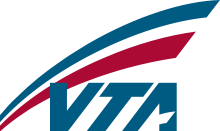Santa Clara Valley Transportation Authority
In 1969, Santa Clara County had three private bus companies, all of which were in serious financial trouble: Peninsula Transit, San Jose City Lines, and Peerless Stages.
[4]: 451 At the time, county voters were reluctant to raise their own taxes to support a local public transit system.
[4]: 437 In its early years the Santa Clara County Transportation District approached the task of replacing the bus fleet it inherited from its predecessors, which was in need of upgrades and repair.
[9] In December 1978, the SCCTD approved an affirmative action plan for the Transportation Agency to improve the diversity of its workforce.
On March 25, 1987, after a long legal battle, the U.S. Supreme Court by a 6-3 majority upheld the gender component of the plan against a civil rights challenge in Johnson v. Transportation Agency.
[11] On January 1, 1995, the SCCTD merged with the county Congestion Management Agency to become the Santa Clara Valley Transportation Authority (SCVTA).
After 2000, due to the dot-com bust, existing revenue sources declined and VTA was forced to cut service and increase fares.
Measure B, added to the November 2016 ballot, would raise $6.3 billion for transit projects via a half-cent increase in sales tax.
[31] On June 13, 2020, VTA opened the first 10-mile-long (16 km) phase of the BART Silicon Valley extension to the Berryessa/North San José station, ceding operations to the Bay Area Rapid Transit District.
[32] In April 2021, the VTA suffered a ransomware attack that disabled many of the agency's computer systems, including the paratransit reservation tracker.
[34] Starting from January 1, 1995,[35]: 9 the Santa Clara VTA special district is governed by a board of directors with 12 voting members[36] composed of political leaders at the city and county level, including the Santa Clara County Board of Supervisors, San Jose City Council, and other cities including Campbell, Cupertino, Fremont, Gilroy, Los Altos, Los Altos Hills, Los Gatos, Milpitas, Monte Sereno, Morgan Hill, Mountain View, Palo Alto, Santa Clara, San Martin, Saratoga, and Sunnyvale.
[40]: 2 From 2004 to 2009, the Board had similar requirements with five San Jose City Councilmembers and two County Supervisors; the five non-San Jose city-level Board members were selected as:[41]: 2 In June 2004, a Santa Clara County Grand Jury criticized the governance structure, calling it "too large, too political, too dependent on staff, too inexperienced in some cases, and too removed from the financial and operational performance of VTA.
[35] Assemblymember Marc Berman (D-Menlo Park) introduced AB 1091 on February 18, 2021,[42] which would reduce the size of the board to nine members, of which five would be appointed by the County Supervisors, two would be from San Jose, and two would be from the remaining cities, split between the northern cities (one member from Palo Alto, Mountain View, Los Altos, Los Altos Hills, Sunnyvale, or Milpitas) and the southern cities (one member from Santa Clara, Campbell, Cupertino, Saratoga, Los Gatos, Monte Sereno, Morgan Hill, San Martin or Gilroy).
The VTA is responsible for building the Silicon Valley BART extension but is not a member of the Bay Area Rapid Transit District.
As VTA covers Santa Clara County in general, it serves the major core city of San Jose (where VTA is based and headquartered), with service to the other municipalities of Campbell, Cupertino, Fremont, Gilroy, Los Altos, Los Altos Hills, Los Gatos, Milpitas, Monte Sereno, Morgan Hill, Mountain View, Palo Alto, Santa Clara, San Martin, Saratoga and Sunnyvale.
Only Campbell, Milpitas, Mountain View, San Jose, Santa Clara and Sunnyvale are served by light rail.
In addition, VTA operates 4 express routes, 8 school trip services, 8 free shuttle routes connecting to ACE commuter rail services, and one commuter shuttle to the Valley Medical Center VTA's longest and most-used bus route is the 22, which connects VTA's Eastridge Transit Center in East San Jose with the Caltrain station in Palo Alto, which serves as a transfer point for SamTrans buses from San Mateo County.
VTA had planned to add distinctive vehicles, separate bus-exclusive lanes on Alum Rock Avenue, El Camino Real, and Stevens Creek Boulevard, ticketing platforms separate from other buses, and possible amenities such as wait time for successive BRT buses by 2016 (making BRT behave more like a light rail or tram system, instead of bus service).
[55] This plan was delayed until February 2022 to direct resources to reducing passenger pass-ups due to capacity limits during the COVID-19 pandemic.
[57] VTA released a request for information in July 2019 to solicit concepts for a grade-separated system that would connect Diridon Station with the San Jose International Airport (SJC), a distance of approximately 3 miles (4.8 km).
The RFI also asked potential bidders to design a continuation to De Anza College along Stevens Creek Boulevard.
One major goal of the RFI was to determine if new technologies could be used to deliver a solution "at significantly lower costs than traditional transit projects.
[64] The VTA headquarters and administration offices are next to the River Oaks light rail station on North First Street in San Jose.
In this role, VTA was responsible for several highway projects such as widening portions of US 101 between San Jose and Morgan Hill, and Interstate 880 within Santa Clara County.




